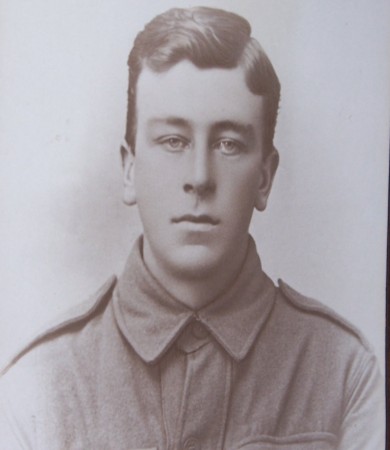Pte
Frederick Cairns Drysdale
Information about birth
|
Date of birth: 18/02/1894 |
|
Place of birth: Wedderburn, Victoria, Australia |
General information
|
Last known residence: Wedderburn, Victoria, Australia |
|
Profession: Railway Engine Cleaner |
|
Religion: Church of Christ |
Army information
|
Country: Australia |
|
Force: Australian Imperial Force |
|
Rank: Private |
|
Service number: 6988 |
|
Enlistment date: 04/09/1916 |
|
Enlistment place: Melbourne, Victoria, Australia |
|
Units: — Australian Infantry, 5th Bn. (Last known unit) |
Information about death
|
Date of death: 20/09/1917 |
|
Place of death: Glencorse Wood, Zonnebeke, Belgium |
|
Cause of death: Killed in action (K.I.A.) |
|
Age: 23 |
Cemetery
|
Tyne Cot Cemetery Plot: XLII Row: G Grave: 16 |
Distinctions and medals 2
|
British War Medal Medal |
|
Victory Medal Medal |
Points of interest 4
| #1 | Place of birth | ||
| #2 | Last known residence | ||
| #3 | Enlistment place | ||
| #4 | Place of death (approximate) |
My story
Frederick Cairns Drysale was born on Feb. 18, 1894. He was the son of James Drysale and Annie Frances Drysale. Family lore reveals that he was asthmatic, so he was found unfit for military service in his hometown. However, Frederick applied and was admitted in Melbourne and he joined the 5th Australian Infantry Battalion, 2nd Brigade, 1st Division as reinforcement. Frederick was killed on September 20, 1917, during the battle known as the Battle of Menin Road. It was part of the larger Battle of Passchendaele. The second brigade managed to take the German positions without too much resistance. Frederick's battalion did lose 67 soldiers and 12 others went missing.
The final objective of the 2nd Australian Brigade on Sept. 20, 1917, was the capture of the western part of Polygon Wood. The attack was divided into the capture of a red, blue and green line. The role of the 5th Australian Battalion was to capture the area up to and including the blue line, which was approximately at the level of Black Watch Corner.
The supporting artillery opened fire exactly at the appointed time and the Australians managed to take the German bunkers. According to the War Diaries, a number of soldiers moved up too quickly and were hit by their own artillery. There were also casualties on the left flank, where the German machine guns had not been eliminated. After eliminating the last pockets of resistance, the battalion was able to consolidate its positions around the blue line. German prisoners of war helped carry off the wounded.
The War Diaries of 5th Battalion describe the attack as a great success. The number of casualties paints a different picture. About a hundred soldiers fell victim to friendly cannon fire and German machine guns also inflicted casualties. Frederick Cairns Drysale was one of the casualties and his Military Record states that he was buried about 100 yards from Glencorse Wood. However, the Commonwealth War Graves Commission burial sheet lists Polygon Wood as the place where he was exhumed some three years later. His identity was determined by his groundsheet. Currently Drysdale rests in Tyne Cot Cemetery, he was 23 years old.
The final objective of the 2nd Australian Brigade on Sept. 20, 1917, was the capture of the western part of Polygon Wood. The attack was divided into the capture of a red, blue and green line. The role of the 5th Australian Battalion was to capture the area up to and including the blue line, which was approximately at the level of Black Watch Corner.
The supporting artillery opened fire exactly at the appointed time and the Australians managed to take the German bunkers. According to the War Diaries, a number of soldiers moved up too quickly and were hit by their own artillery. There were also casualties on the left flank, where the German machine guns had not been eliminated. After eliminating the last pockets of resistance, the battalion was able to consolidate its positions around the blue line. German prisoners of war helped carry off the wounded.
The War Diaries of 5th Battalion describe the attack as a great success. The number of casualties paints a different picture. About a hundred soldiers fell victim to friendly cannon fire and German machine guns also inflicted casualties. Frederick Cairns Drysale was one of the casualties and his Military Record states that he was buried about 100 yards from Glencorse Wood. However, the Commonwealth War Graves Commission burial sheet lists Polygon Wood as the place where he was exhumed some three years later. His identity was determined by his groundsheet. Currently Drysdale rests in Tyne Cot Cemetery, he was 23 years old.
Connection to other soldiers 1
|
Alfred Oswald Binger
Neef |
Sources 4
|
5th Battalion Australian Infantry, (Australian War Memorial, Campbell (AWM), AWM4 23/22/31). https://www.awm.gov.au Sources used |
|
Facebook post, Peninsula veterans, verhaal Jennifer Murray. https://www.facebook.com/spvc.net.au/photos/a.573987965958285/3301227536567634/?type=3 Sources used |
|
First Australian Imperial Force Personnel Dossiers, 1914-1920, (National Archives of Australia, Canberra (NAA), B2455, Drysale Frederick Cairns). https://www.awm.gov.au/ Sources used |
|
McCarthy, Chris. Passchendaele: The Day by Day Account (Londen: Arms & Armour Press, 2018), 81. Sources used |
More information 4
|
Commonwealth War Graves Commission Database https://www.cwgc.org/find-records/find-war-dead/casualty-details/462622 |
|
Namenlijst (In Flanders Fields Museum) https://namenlijst.org/publicsearch/#/person/_id=26702778-3b0e-405b-947b-4d60e30cd679 |
|
The AIF Project (UNSW Canberra) https://aif.adfa.edu.au/showPerson?pid=84345 |
|
Lives of the First World War (Imperial War Museum) https://livesofthefirstworldwar.iwm.org.uk/lifestory/7423588 |
